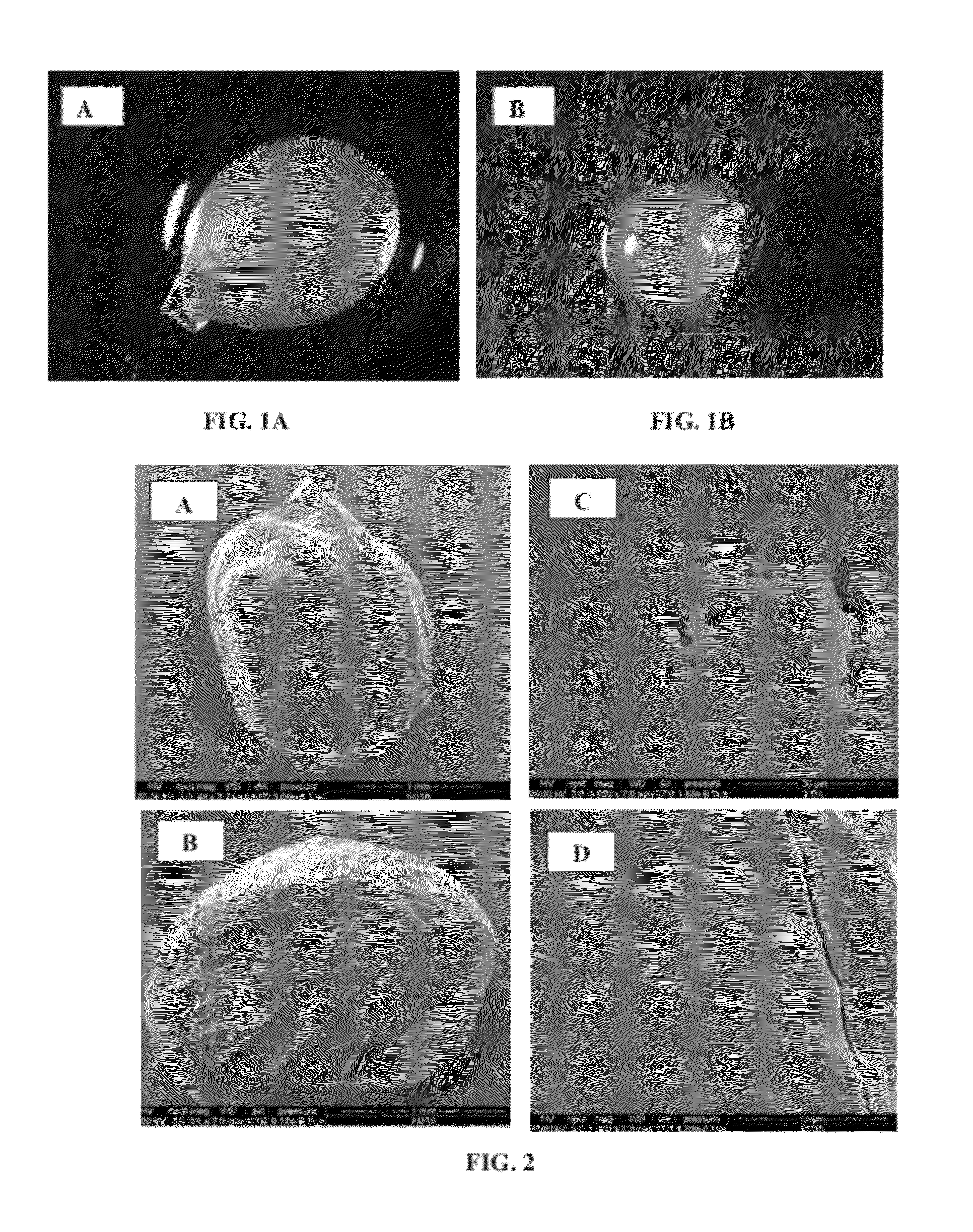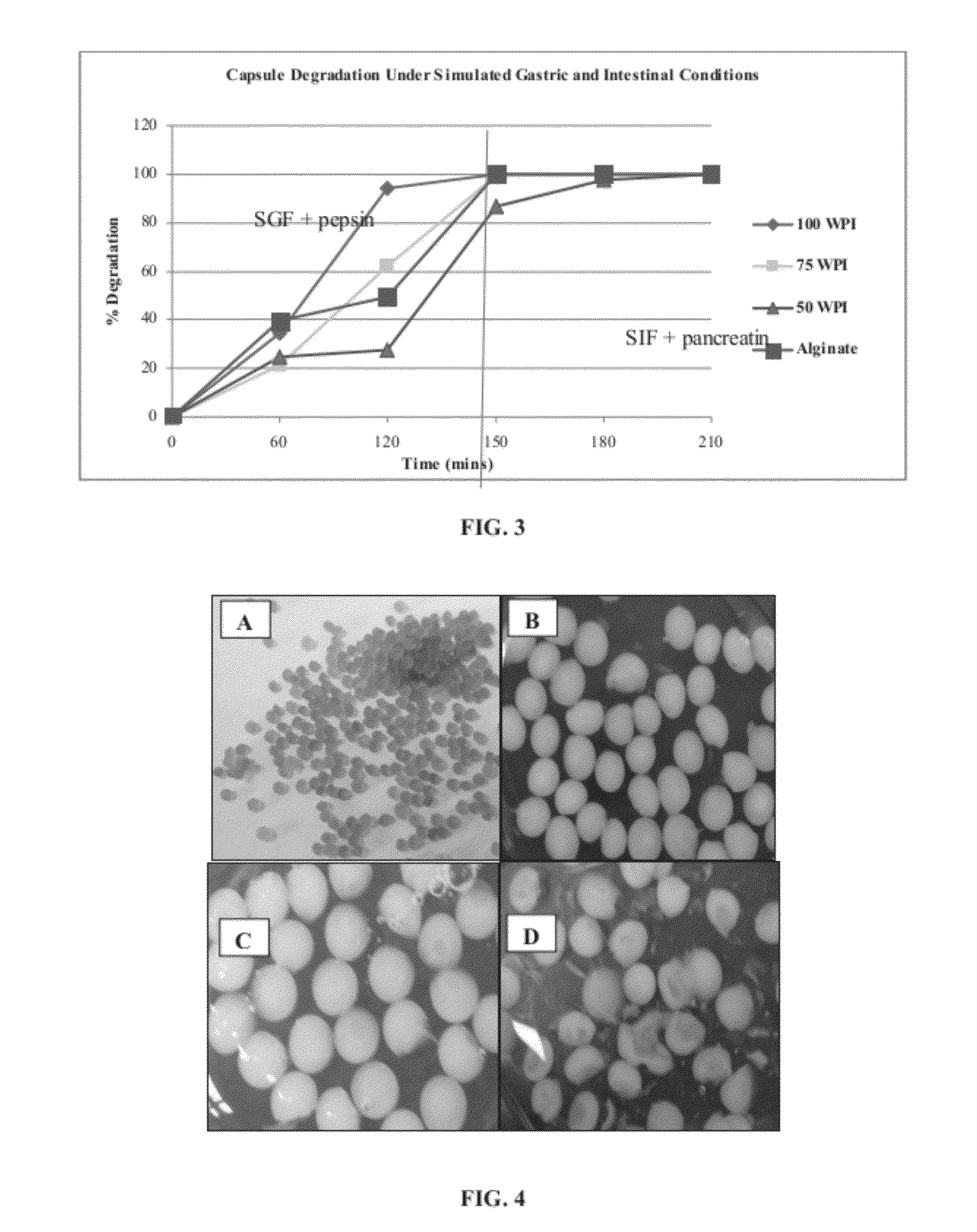Encapsulation system for protection of probiotics during processing
a probiotic and encapsulation system technology, applied in the field of encapsulated nutrients, can solve the problems of short shelf life of beverages containing these organisms, short shelf life of beverages, and inability to survive for long periods of tim
- Summary
- Abstract
- Description
- Claims
- Application Information
AI Technical Summary
Benefits of technology
Problems solved by technology
Method used
Image
Examples
example 1
[0123]The use of food grade biopolymers, whey protein isolate and alginate, as encapsulating agents for probiotic bacteria was investigated. More particularly, two different ratios of whey protein isolate and alginate were studied in the manufacture of capsules comprising probiotic bacteria, and compared to capsules comprising 100% whey protein isolate or 100% alginate.
[0124]Whey Protein Isolate (˜60% β-lactoglobulin and 20% α-lactalbumin) was supplied by Fonterra (Palmerston North, New Zealand) and high viscosity Na-alginate (Protonal SF120) was supplied by Hawkins Watts (Auckland, New Zealand). Lactobacillus acidophilus ATCC 4356 was purchased from Environmental Science and Research (ESR, Wellington, New Zealand) and cultured in Lactobacilli MRS broth (Difco, New Zealand) at 37° C. under anaerobic conditions (GasPak EZ anaerobe container system, Becton, Dickinson and Company, USA). Activated cultures were obtained by sub-culturing 2-3 times in MRS broth for 24 hours at 37° C. befo...
example 2
Capsule Degradation Studies in Simulated Gastric and Intestinal Conditions
[0130]The behavior of both dried and wet capsules as prepared in Example 1 in simulated gastric fluid (SGF, pH 2.0) was observed, as the drying process was expected to affect the pore size and other attributes of the capsules may have influenced their stability in SGF.
[0131]SGF (pH 2±0.1) containing 0.2% NaCl, 0.7% HCl and 0.3% pepsin was prepared. Approximately 1 gram of encapsulated cells was added separately to test tubes containing 9 milliliters of SGF. Test tubes were incubated at 37° C. for 2 hours under continuous agitation (150 rpm) in a shaking water bath. A two hour incubation time was selected to represent the mean transit time through the stomach. The weight of the capsules was determined initially and then hourly up to 2 hours. Next, capsules were removed from SGF and placed in simulated intestinal fluid (SIF, pH 7.4±0.1, 37° C.) and weighed at intervals of half an hour until complete degradation ...
example 3
Texture Analysis
[0132]The capsules of Example 1 were assessed for their textural characteristics using a Texture Analyzer XT-2 (TA XT-2) Plus system (Stable Micro Systems, Surrey, UK). The texture analysis was conducted with the settings as shown below in Table 2. The piston went down, keeping contact with the top of the capsules, and flattened the capsule at a constant rate of 0.2 millimeters per second (mm / s), until it reached 90% of its original height. The force exerted by the capsule as a function of displacement was recorded. The return speed of the piston to its original position after compression was 10 mm / s. The force needed for deformation was recorded as a function of time until fracturing of the capsules. A force-compression curve was obtained for each sample and stored in a file for calculation of the fracture properties using the “XT.RAD Dimension” software, version 3.7H, from Stable Micro System (Surrey, UK). From each measurement, the stress and strain at fracture we...
PUM
 Login to View More
Login to View More Abstract
Description
Claims
Application Information
 Login to View More
Login to View More - R&D
- Intellectual Property
- Life Sciences
- Materials
- Tech Scout
- Unparalleled Data Quality
- Higher Quality Content
- 60% Fewer Hallucinations
Browse by: Latest US Patents, China's latest patents, Technical Efficacy Thesaurus, Application Domain, Technology Topic, Popular Technical Reports.
© 2025 PatSnap. All rights reserved.Legal|Privacy policy|Modern Slavery Act Transparency Statement|Sitemap|About US| Contact US: help@patsnap.com



